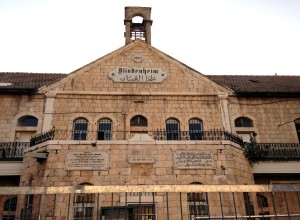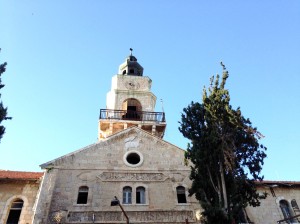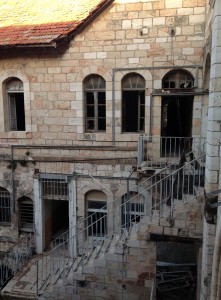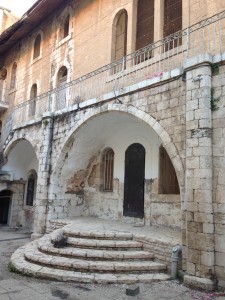The civil war which has been raging in Syria for the past three years has so far managed to avoid spilling over into the borders of Israel, with a few minor exceptions. However, Syrian refugees, both civilians and combatants, have been coming to our northern border and requesting medical aid. So far, over one thousand of them have been treated either in mobile aid stations or in Israeli hospitals, with that number rapidly rising. Whilst this humanitarian response to members of an enemy state goes barely noticed in the western media, this is not the first time that the country has played host to war victims from Syria.
In 1860, under Ottoman rule, tensions escalated between the Maronite Christian and Druze communities in Lebanon. This led to an all out war between the two groups and the fighting spread to Damascus. The Turks sided with the Druze and backed them with military assistance. As a result, a massacre took place in which approximately 11,000 Christians were slaughtered, leaving 20,000 widows and orphans.
Johann Ludwig Schneller, a German Protestant missionary who was living in Jerusalem at the time, was moved to try to rescue some of these children who had become orphans. He traveled to the region but the locals were distrustful of his motives and he returned with only nine youngsters. Nevertheless, he began to build an orphanage for them. By the end of the following year the number of children in his care had risen to forty-one and by the end of the century there were one hundred and thirty students at the orphanage, including boys and girls and a number of blind children. By 1896, when Schneller died, 1,500 pupils had passed through the institution. He is buried together with his wife in the Protestant cemetery on Mount Zion.
In the beginning, construction was financed by donations from the European Protestant community. But in 1898, the Kaiser came to visit the orphanage whilst he was in Jerusalem for the laying of the cornerstone of the Lutheran church in the Old City. From that point on, fundraising became a whole lot easier. Three years later a German nobleman bequeathed his entire estate to the school on condition they establish a school for the blind. A building which housed forty to fifty children was built for this purpose. A donor’s commemorative plaque in Hebrew and Arabic can be seen above the entrance.
After the Kaiser’s visit, he sent three large bells as a gift and these were incorporated into a bell tower. It was built in the “onion tower”, baroque style of those in Southern Germany of the day. The words Syrisches Waisenhaus (Syrian Orphanage) were engraved on the structure and above them a stone relief of a lamb carrying a pennant with a cross on it. There was also a quotation from the gospel of Luke in both Hebrew and Arabic. Whilst the external buildings of the orphanage appeared very Germanic in style, the interior structures incorporated more local architectural features such as arches. 
The children attending the orphanage spanned the full range of Christian denominations and as well as those from Lebanon and Syria there were also pupils from Egypt, Transjordan, Ethiopia and Central Africa. In addition, underprivileged children from all over the country studied there. Lessons were taught in either Arabic or German and secular subjects were an integral part of the curriculum. Text books were printed especially for them, including books in braille.
 Each pupil was also taught a trade so they could become productive members of society. Fifty-five craftsmen, many of them especially brought over from Germany, were part of the teaching staff. A whole complex was eventually built to house and teach the orphans. As well as the workshops there was also a laundry and a windmill and Schneller rented agricultural land in order to grow crops. He later added a teacher’s training college and a factory which manufactured roof tiles. There was even a small museum on the grounds, which, by the beginning of World War One, spread over 500,000 square metres.
Each pupil was also taught a trade so they could become productive members of society. Fifty-five craftsmen, many of them especially brought over from Germany, were part of the teaching staff. A whole complex was eventually built to house and teach the orphans. As well as the workshops there was also a laundry and a windmill and Schneller rented agricultural land in order to grow crops. He later added a teacher’s training college and a factory which manufactured roof tiles. There was even a small museum on the grounds, which, by the beginning of World War One, spread over 500,000 square metres.
The orphanage continued to operate until the First World War when the compound was taken over by the Turkish army and used as a barracks. In the interim years between the two world wars Schneller’s son and grandson managed to modernize and manage the buildings. However, in the Second World War the British confiscated the property and turned it into a closed military camp. They installed about 50 watchtowers and huts and the area became known as the Schneller Barracks. When the British abandoned the property in 1948, it became the headquarters of the Hagana during the War of Independence. For the next 60 years the compound served as a base for the Israel Defence Forces. At the beginning of the 1950’s the Israeli’s called in representatives of the Lutheran church to take away and preserve any religious artifacts.
In 2008 the army vacated the premises, which currently comprise a prime area of Jerusalem real estate. Ironically, this is a far cry from their humble beginnings when they were one of the first institutions to be built outside the Old City walls. This was a project fraught with danger as the area was rife with roaming bandits who had no compunction about attacking isolated properties. Having suffered a number of such attacks on his private residence, Schneller had a three and a half metre protective wall built around the orphanage. Together with the addition of watchtowers set up by the Ottoman government to secure the area, the residents were thus provided with a measure of safety. Alongside the development of early neighbourhoods such as Mishkenot Sha’ananim and the Russian Compound, the Schneller orphanage was instrumental in providing the city’s inhabitants with enough confidence to start construction outside the city walls. 
Over the years, several ideas were bandied about by the Jerusalem municipality how to safeguard and preserve the historic buildings which are situated today in the midst of the ultra-orthodox enclave of Geula. Ultimately economic interests won out and approval has been given for six multi storey buildings to be erected on the site to provide an exclusive and prestigious housing complex for the ultra-orthodox community. It is unclear just how much of the original structure will survive once the contractors start their work in earnest. This prompted me to take a wander around the now abandoned compound to photograph what remains and some of the fruits of my labour can be seen here.
.

